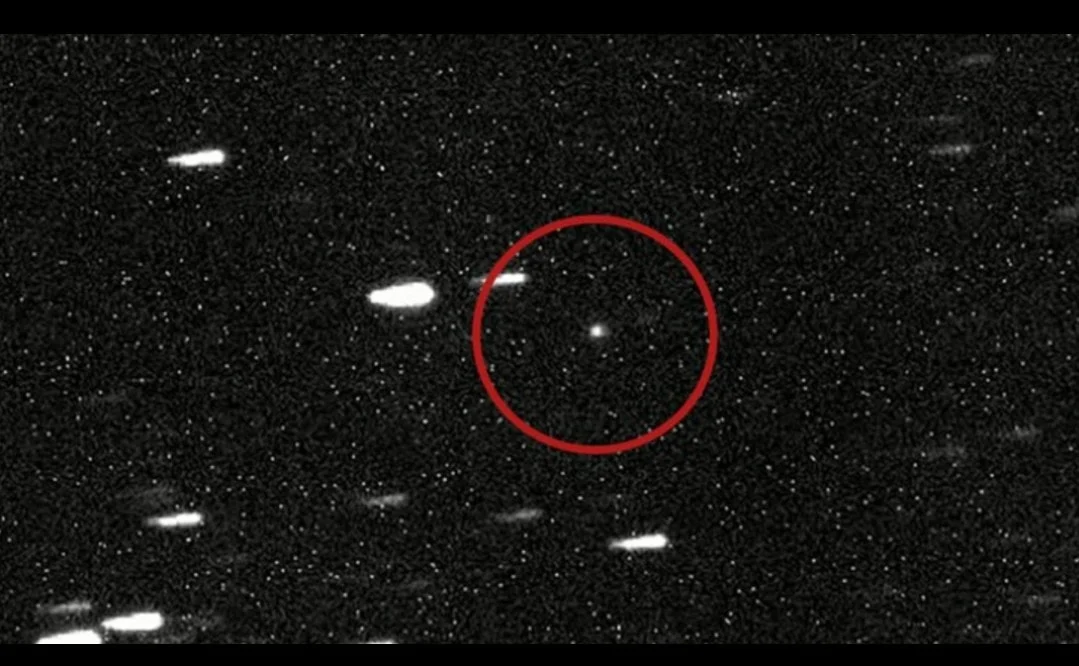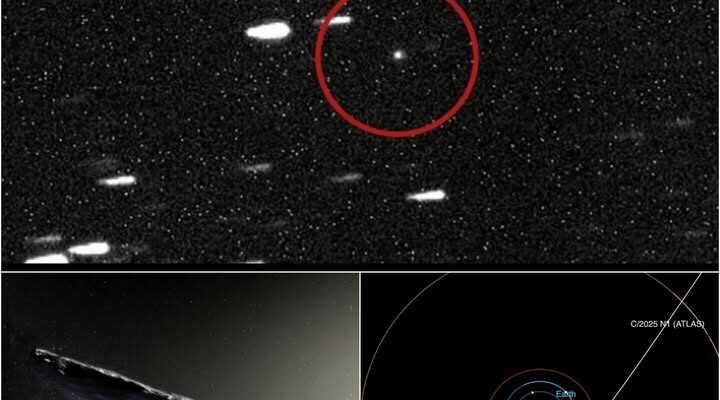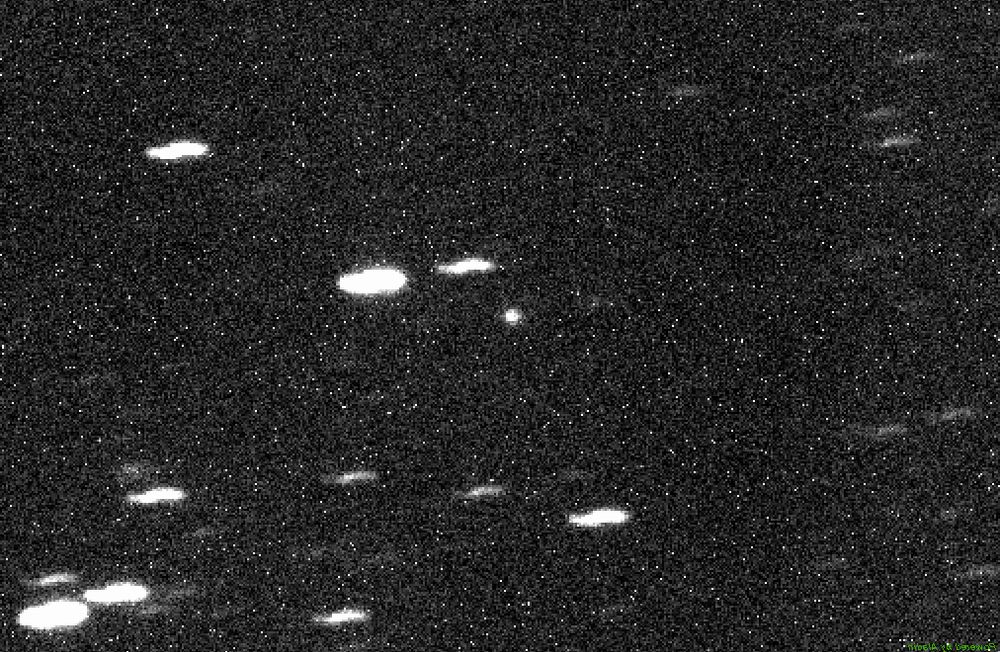A cosmic spectacle is unfolding in our solar system! On July 1, 2025, NASA’s ATLAS telescope spotted a massive interstellar object, now officially named 3I/ATLAS or C/2025 N1, hurtling toward the sun at a blistering 150,000 miles per hour—four times faster than NASA’s Voyager 1, the farthest human-made object in space. Estimated to be up to 12 miles wide, this comet is only the third confirmed interstellar visitor ever observed, following ‘Oumuamua in 2017 and 2I/Borisov in 2019. Set to pass near Mars in October and swing by Earth in December, 3I/ATLAS poses no threat but offers a rare chance to study a relic from another star system. Social media platforms like X are buzzing with excitement and speculation—could this be a natural comet or something more mysterious? Let’s dive into the details of this interstellar interloper, its journey, and what it means for science and our understanding of the cosmos.

A Rare Interstellar Guest: What We Know About 3I/ATLAS
Discovered by the NASA-funded Asteroid Terrestrial-impact Last Alert System (ATLAS) in Chile, 3I/ATLAS was first detected in data from June 25–29, 2025, with earlier sightings traced back to June 14. Its hyperbolic trajectory and high speed—around 68 kilometers per second (152,000 mph) relative to the sun—confirm it originates from outside our solar system, likely traveling for millions of years from another star system. The International Astronomical Union’s Minor Planet Center designated it 3I/ATLAS on July 2, noting tentative signs of cometary activity, such as a marginal coma and a short 3-arcsecond tail, indicating it’s a comet rather than an asteroid.
The comet’s size is estimated at 10–20 kilometers (6–12 miles) in diameter, making it significantly larger than ‘Oumuamua (300–1,300 feet) and 2I/Borisov (about half a mile). Its brightness, currently at magnitude 18.8, suggests it could be even larger if composed of ice, which reflects more light. Unlike typical solar system comets, 3I/ATLAS follows an open, hyperbolic path, meaning it won’t be captured by the sun’s gravity and will exit our solar system after its visit.
The Journey: Mars Flyby and Earth Encounter
Currently located between Jupiter and the asteroid belt, about 420 million miles (670 million kilometers) from Earth, 3I/ATLAS is speeding toward its closest approach to the sun (perihelion) on October 30, 2025, at 1.4 astronomical units (AU), or roughly 130 million miles, just inside Mars’ orbit. On October 2, it will pass within 0.4 AU (37 million miles) of Mars, close enough for potential observation by NASA’s Mars Reconnaissance Orbiter, though it will appear as a mere 0.2 pixels in images. In December, likely on December 19, the comet will make its closest approach to Earth at 1.6 AU (150 million miles), posing no danger but offering a window for detailed study.
Astronomers worldwide are mobilizing to observe 3I/ATLAS, which will remain visible through ground-based telescopes until September, when it passes too close to the sun. It will reemerge in early December, allowing further observations into mid-2026. The Vera C. Rubin Observatory, recently operational, is expected to enhance tracking of such objects, potentially spotting interstellar visitors monthly.
Scientific Significance: A Window to Other Worlds
The discovery of 3I/ATLAS is a scientific goldmine. As Dr. Paul Chodas, director of NASA’s Center for Near Earth Object Studies, notes, its trajectory confirms it originated from another solar system, likely ejected by gravitational interactions with another star. Studying its composition, shape, and rotation could reveal how comets form in distant protoplanetary disks, offering clues about the building blocks of planets beyond our solar system. Dr. Mark Norris of the University of Central Lancashire suggests up to 10,000 interstellar objects may drift through our solar system at any time, most too faint to detect, making 3I/ATLAS a rare opportunity.
The comet’s brightness and speed set it apart from ‘Oumuamua and 2I/Borisov. ‘Oumuamua, with its cigar-like shape and unexpected acceleration, sparked debate about possible artificial origins, though most scientists attribute it to natural processes. 2I/Borisov, a clear comet, provided more observation time. 3I/ATLAS, with its size and early detection, allows astronomers to use spectrometers to analyze its makeup, potentially confirming similarities to solar system comets or revealing unique traits. Harvard’s Avi Loeb, who speculated ‘Oumuamua might be an alien probe, suggests using the James Webb Space Telescope to check 3I/ATLAS for non-gravitational acceleration, though most experts lean toward a natural explanation.

The Alien Debate: Fact or Fiction?
The arrival of 3I/ATLAS has reignited speculation on X, with some users calling it a “cosmic show” and others hinting at extraterrestrial origins, fueled by its size and brightness. Posts like @JayTowers’ note its “wildly glowing” appearance, while @Bear_Battleborn dubs it an “alien rock.” However, astronomers like Richard Moissl of the European Space Agency emphasize there’s no evidence of artificial origins. Its trajectory and cometary features align with natural objects, and its high eccentricity (estimated at 6–10.4) indicates a typical interstellar comet unbound by our sun. Still, the possibility of advanced telescopes detecting unusual properties keeps the debate alive, especially after ‘Oumuamua’s mysteries.
Challenges and Opportunities
Studying 3I/ATLAS presents challenges. Its faint magnitude (18.8) makes it invisible to backyard telescopes, requiring powerful observatories like the Lowell Discovery Telescope or Vera C. Rubin. Its speed means it will zip through the inner solar system quickly, limiting observation time. Unlike ‘Oumuamua, spotted after its closest approach, 3I/ATLAS was caught early, giving astronomers months to prepare, but a mission to intercept it is infeasible, as noted by Mark Norris: “If we launched today, the thing’s already gone.” The European Space Agency’s Comet Interceptor, set for 2029, could target future visitors, but for now, remote observations are key.
The rewards, however, are immense. If 3I/ATLAS contains the same building blocks as Earth’s comets, it could bolster theories that interstellar objects seeded life here. Its path from the Milky Way’s galactic center, unlike the directions of ‘Oumuamua and 2I/Borisov, adds intrigue about its origins. The Virtual Telescope Project’s livestream on July 3 captured its sharp point of light against trailing stars, sparking public interest. As it brightens near perihelion, it may offer stunning data, especially if Mars rovers or the James Webb Space Telescope capture detailed images.
Public Fascination and Future Prospects
On X, the excitement is palpable. @Physicsastronmy highlights 3I/ATLAS’s speed, comparing it to Voyager 1, while @pascalleetweets notes its safe distance and scientific potential. The comet’s size—potentially a “planet killer” if it were on a collision course—adds drama, though experts like Larry Denneau of ATLAS stress it poses no risk. If it hit Earth (it won’t), its impact would dwarf the dinosaur-killing asteroid’s. This mix of awe and reassurance fuels engagement, with users urged to watch livestreams or follow updates from observatories. The Vera C. Rubin Observatory’s future discoveries could make such events routine, transforming our understanding of interstellar visitors.
The arrival of 3I/ATLAS, a 12-mile-wide interstellar comet speeding through our solar system at 150,000 mph, is a once-in-a-decade cosmic event. Its journey past Mars in October and Earth in December offers a fleeting chance to study a visitor from another star system, potentially unlocking secrets about the universe’s building blocks. While speculation about alien origins swirls on X, scientists are focused on its natural properties, using cutting-edge telescopes to probe its mysteries. As 3I/ATLAS races toward the sun, the global astronomical community—and curious fans—are watching closely. Will it reveal new insights about distant worlds, or remain an enigmatic traveler?




